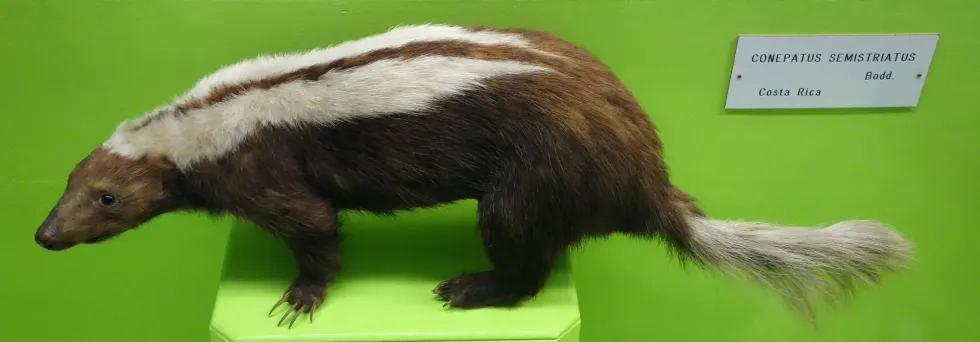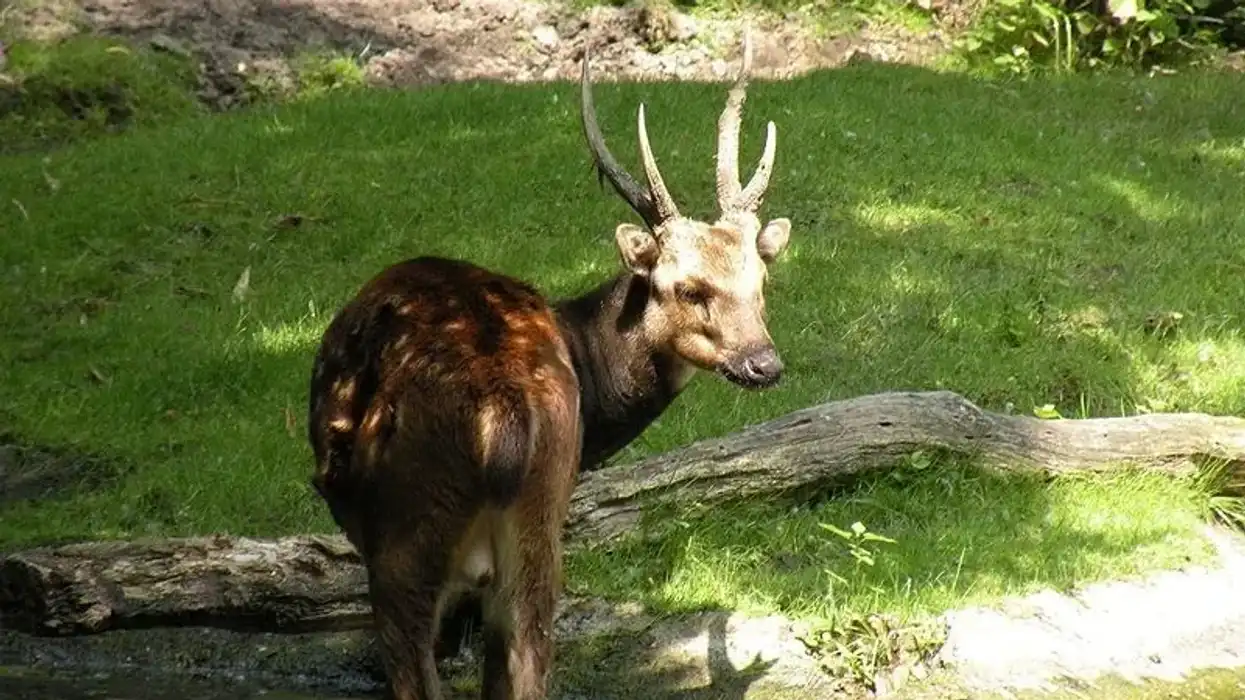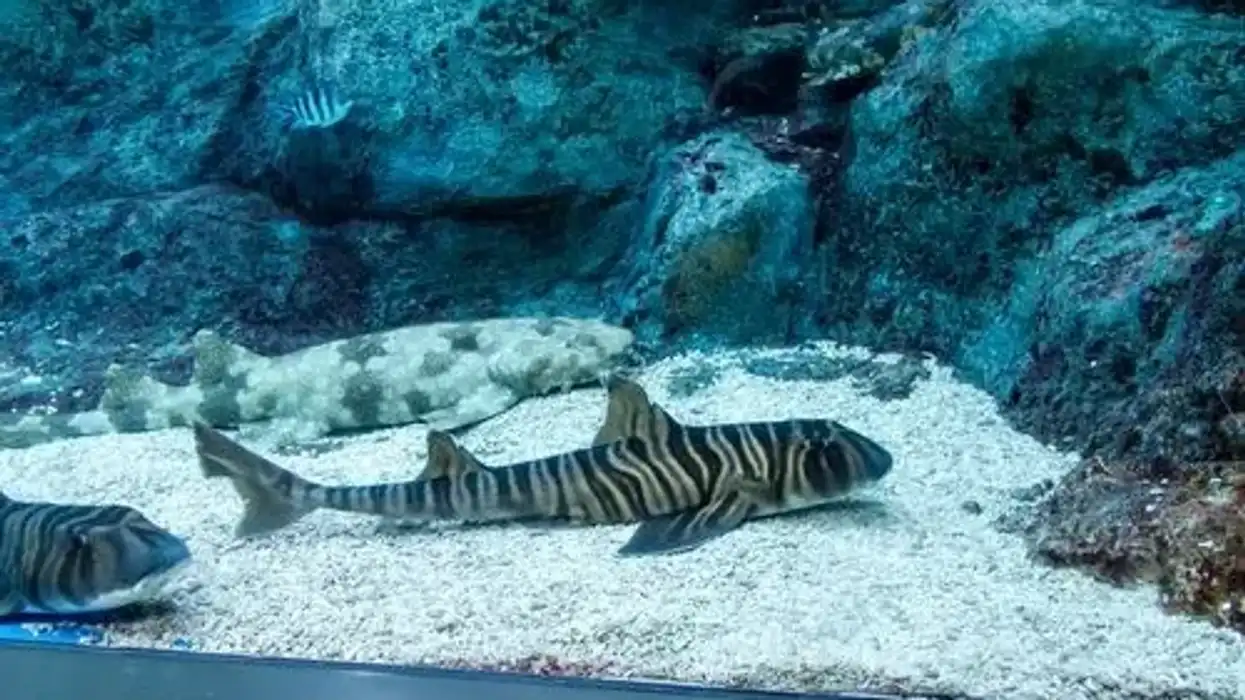Skunks are infamous for their ability to secrete an extremely foul-smelling liquid from specialized anal glands when agitated. The striped hog-nosed skunk (Conepatus semistriatus) is a skunk species found across southern and islandic North America, as well as Central and South America.
They belong to the genus Conepatus, commonly referred to as the hog-nosed skunks due to their protruding snouted nose with bare nostrils, physically similar to that of a pig.
This genus includes three other species of skunks, namely the American hog-nosed skunk (Conepatus leuconotus), Molina's hog-nosed skunk (Conepatus chinga), and Humboldt's hog-nosed skunk (Conepatus humboltdii).
These are some of the largest skunk species of all, but the striped hog-nosed skunks in particular are quite small mammals. The striped hog-nosed skunk looks almost exactly the way you might imagine.
It has dark brown or black body coat and a bright white stripe that starts at the top of the head and eventually separates into two and ends at the base of the tail. This white stripe is unique to every individual and may vary drastically.
Striped hog-nosed skunks have a breeding season around March every year, and after a gestation period of around two months, their kits are born around May.
If you go on to enjoy these interesting facts on the striped hog-nosed skunk, make sure to check out our facts pages on the striped skunk and the polecat.
Striped Hog-Nosed Skunk Interesting Facts
What type of animal is a striped hog-nosed skunk?
The striped hog-nosed skunk is a species of skunk.
What class of animal does a striped hog-nosed skunk belong to?
Striped hog-nosed skunks fall under the biological class Mammalia, which means they give birth to live offspring and breastfeed them in their youth using their mammary glands.
How many striped hog-nosed skunks are there in the world?
While the exact number of striped hog-nosed skunks in the wild is not known, it is commonly found within its habitat range since it is able to adapt to a wide range of geographic settings.
Where does a striped hog-nosed skunk live?
This species of small mammals can be found in Mexico, Costa Rica, Guatemala, Brazil, and Peru.
What is a striped hog-nosed skunk's habitat?
Striped hog-nosed skunks are most often seen in sparsely vegetated savannahs and usually avoid dense forests. The species can also be found in desert areas and rocky timberlands. In these habitats, they dig their own holes or use those dug by other animals (like moles) to shelter themselves from nature and predators.
Who does striped hog-nosed skunk live with?
Striped hog-nosed skunks are very solitary animals and are only see in pairs during the breeding season. This is one of the many similarities they share with American hog-nosed skunks (Conepatus leuconotus).
How long does a striped hog-nosed skunk live?
While this particular species' lifespan has never been recorded, another species in the same kingdom, phylum, family, genus, and behavior was seen to have lived nearly nine years in captivity. It is also not known if this longevity is different from that in the wild.
How do they reproduce?
Striped hog-nosed skunks reproduce sexually and are polygynous, meaning the male is free to pursue other mates after impregnating a female. The female, on the other hand, is tasked with birthing and taking care of the kits alone. A litter of around one to five after a gestation period of 66 days is the most common in the species.
What is their conservation status?
The striped hog-nosed skunk is listed on the International Union for Conservation of Nature (IUCN) Red List of Threatened Species as a species of Least Concern, in no small part due to the species' ability to adapt to a large range of habitats.
Striped Hog-Nosed Skunk Fun Facts
What does the striped hog-nosed skunk look like?
The striped hog-nosed skunk is on the smaller end in the skunk society, growing to only 12-20 in (30-52 cm) with a tail around half as long as its body as an adult.
Their body is covered in short black or dark brown fur, and a single white stripe starting at the top of its head eventually separates into two as it reaches the base of its tail.
As a species of skunk does, they possess special anal glands on their posterior that can squirt a volatile and offensive-smelling liquid accurately in order to ward off predators.
When kept as pets, these glands are often surgically removed.
Every species in the hog-nosed genus has a snout and bare nostrils which it uses to look for food by sniffing along the ground. The striped hog-nosed skunk's ability to create a stinking odor and the prominent stripe on its back often leads to it being mistaken for a striped polecat.
Despite the many similarities, the two mammals are only distantly related.

How cute are they?
These skunks can be cute species to cuddle with and play with and are quickly becoming popular pets.
How do they communicate?
Skunks are mostly verbal communicators and can make a variety of sounds, including whining, growling, screeching, cooing, and chattering to convey their mood or status to other individuals. When tamed, these are mostly restricted to cooing and chattering.
How big is a striped hog-nosed skunk?
Striped hog-nosed skunks grow to around 12-20 in (30-52 cm), meaning they are almost half the size of a fox and nearly three times smaller than the average wolf.
How fast can a striped hog-nosed skunk run?
Skunks are surprisingly fast creatures, recorded hitting top speeds of 10 mph (16 kph).
How much does a striped hog-nosed skunk weigh?
The average adult striped hog-nosed skunk weighs around 4.5 lb (2 kg).
What are the male and female names of the species?
A male skunk is called a buck, and a female, a doe. Thus, the male and female of this species can be called the striped hog-nosed buck and doe, respectively.
What would you call a baby striped hog-nosed skunk?
A baby skunk is called a kit, meaning the young of this species can be referred to as striped hog-nosed kits.
What do they eat?
Skunks are mostly carnivorous in nature, eating a variety of insects like beetles and fleas, small vertebrates like lizards and salamanders, and even the occasional snake. They also enjoy eating berries, leaves, roots, and nuts.
Are they poisonous?
While they may not produce poisonous toxins, their offensive-smelling liquid and bite can both carry diseases like rabies and distemper especially if the individual is from the wild.
Would they make a good pet?
Yes, only provided it is legal in your home country to remove their anal glands, which ensures there is absolutely no chance of them spraying anyone they meet. They are generally docile and will enjoy your companionship, provided it is tamed early in their life.
Did you know...
Most skunks are crepuscular in nature, meaning they are most active at dusk and dawn. This is an evolutionary trait seen in many other prey animals due to the fact that when the sun is low in the sky, shadows are far longer, meaning predators are easiest to spot.
Why are they called a striped hog-nosed skunk?
The etymology of their name is simple. They sport a prominent stripe on their back and have a pig-like nose that they use to find food.
How is a hooded skunk different from a striped skunk?
The hooded skunk belongs to the genus Mephitidae, a large genus of skunks, while the striped skunk is a hog-nosed skunk belonging to the genus Conepatus. This means that the hooded skunk does not possess a long snout for a nose with barely any fur around it.
Apart from this, the hooded skunk also shows a different coloration, with a collection of white fur near its eyes, giving root to its common name.
Here at Kidadl, we have carefully created lots of interesting family-friendly animal facts for everyone to discover! For more relatable content, check out these Asiatic black bear facts and Sri Lankan Elephant facts pages.
You can even occupy yourself at home by drawing one on our free printable Skunk coloring pages.










